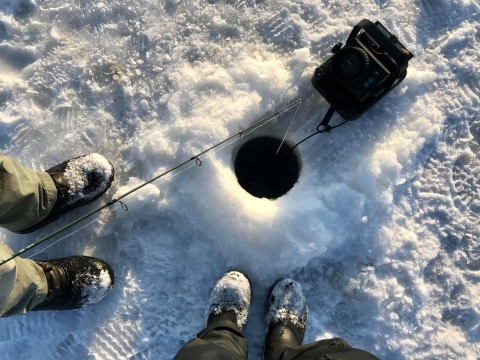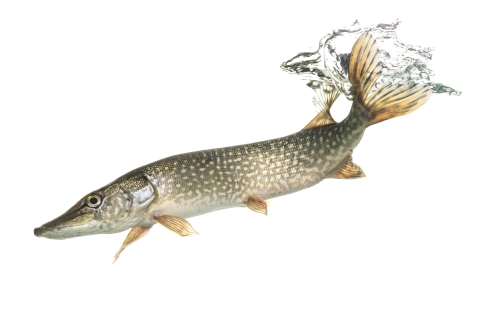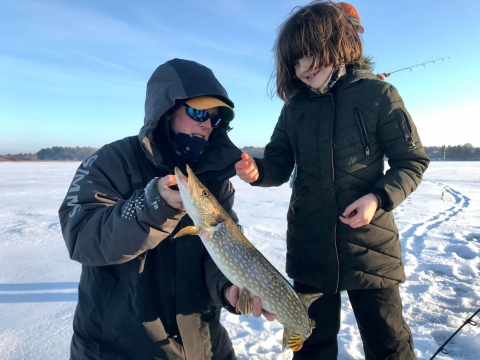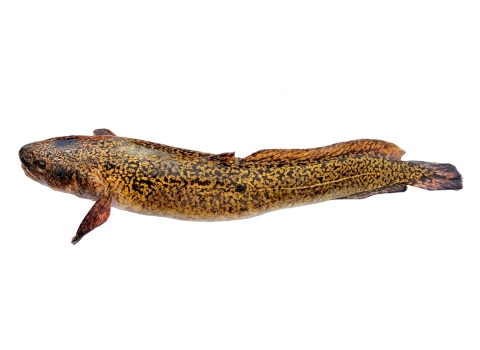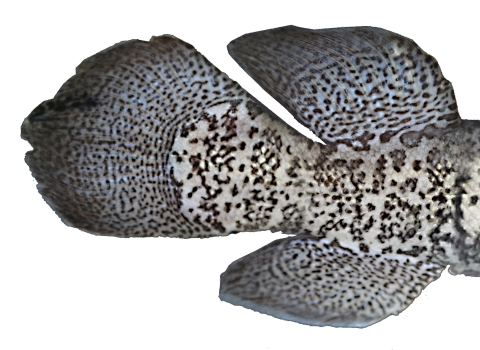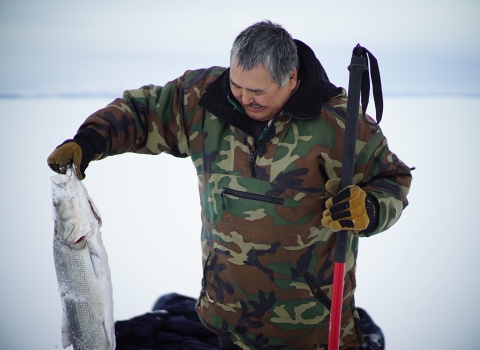Toothy and sleek, there are all kinds of aggressive nicknames for this sit-and-wait predator: Northacuda. Slough Shark. Hammer Handle. Water Wolf. Similar species include muskies and pickerels.
Northern Pike are a serious piscivore — meaning they eat other fish. Unlike fish built for roving around and migrating, pike have their fins loaded toward their back end. This gives them explosive power from a standstill when they whip their tail. The ambush prey (like whitefish or juvenile salmon or longnose suckers) in an explosion from a bed of weeds or from behind a submerged log.
A popular sport and food fish, Northern Pike are found throughout the upper mid-western states, Canadian provinces, and much of Alaska naturally.
If you catch a Northern Pike, you’ll want to keep in mind that not just the inside of the mouth is toothy, but also the inside of the gills. It’s not really dentition, but it definitely pokey. If you put your fingers under its operculum (gill covering) to break the gill arch/bleed the fish in preparation to eat it, you can get cut if you’re not careful.
“Pike are super aggressive. One time was fishing for pike and I was wading around in this lake and I spooked one. I tossed a little inline spinner in front of it. That thing stopped in its tracks. It knew I was there, but it came back, followed that lure, and SMASHED it. They’ll smash anything shiny. They are so fun!” — Guy Eroh
Pike as Table Fare
Northern Pike are an excellent food fish. They have white, flaky meat. While they’re considered “bony” you can get five nice fillets off a 24+ inch long pike. Sharpen your fillet knife frequently to ensure you get the most meat possible and have nice clean cuts.
Once you’ve iced your pike and are ready to fillet it, set it stomach-down and cut behind the head with your fillet knife until you feel your knife hit spine. Then turn your knife towards the tail and slide your knife down its back parallel to your cutting board until you hit the dorsal fin. That’s the back fillet, or the “back strap”. You’ll see a line of Y-bones on either side and you’re going to take two fillets off either side, on the outside of those bones. To do this, you’ll lay the fish on its side and make two cuts perpendicular to its back. One at the head and one to the front of its anal fin. Then slide your knife down along the ribs from front to back. For the two final fillets make a perpendicular cut just behind its anus and slide your knife to its tail fin. Repeat on the other side and you should have five fillets. You’ll skin those fillets and are now ready to prepare a meal!
Before you go
Always let a trusted contact know where you are going and when you plan to return. Whenever possible, leave a written note as well. Accidents happen and, in a worst case scenario, you’re going to want a search party have the best possible chance of finding you. Be sure to always notify your point of contact if your plans change. For instance if fishing is going poorly and you want to change locations, or if fishing is going well and you’re going to return later than planned. Finally, when you do come home from your trip be sure to let your contact know. And always check the Alaska Department of Fish and Game regulations.
More Pike!
We honor, thank, and celebrate the whole community — individuals, Tribes, States, our sister agencies, fish enthusiasts, scientists, and others — who have elevated our understanding and love, as people and professionals, of all the fish. In Alaska we are shared stewards of world-renowned natural resources and our nation’s last true wild places. Our hope is that each generation has the opportunity to live with, live from, discover and enjoy the wildness of this awe-inspiring land and the people who love and depend on it.


